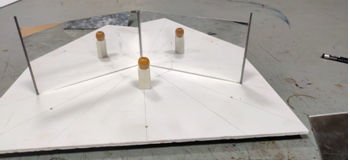MAKE YOUR OWN KIT: IMAGES IN INCLINED MIRRORS
When an object is placed between two or more mirrors, the light rays are reflected back and forth several times producing a number of images which are basically images of images. This phenomenon is called the Multiple Reflection of light. Various devices like Kaleidoscopes and Periscopes make use of the principle of multiple reflections of light to produce a number of images in repetitive manner. While in a Kaleidoscope, the array of images formed due to successive reflections merge together to form different patterns, in a Periscope, repeated reflections in a set of two parallel mirrors allow the observer to see an object placed at a different height compared to his/her eye level .The number of images formed in two inclined mirrors when an object is placed in front of the mirrors is in accordance with the following mathematical formula:
n = 3600/θ - 1
where, n = No of Images formed and
θ = Angle of inclination of the two mirrors in degrees
The following Table gives the number of images formed with a given angle of inclination:
|
θ in degrees |
No of images formed |
Remarks |
|
0 |
Infinite |
Parallel mirrors |
|
30 |
11 |
Acute angle between the mirrors. |
|
45 |
7 |
Acute angle between the mirrors. |
|
60 |
5 |
Acute angle between the mirrors. |
|
90 |
3 |
Perpendicular Mirrors |
|
120 |
2 |
Obtuse angle between the mirrors |
|
180 |
1 |
The two mirrors merge into a single plane mirror. |
|
360 |
0 |
No reflecting surface is visible |
Materials Required:
·
Toggle Switch- 1no
·
Foam Sheet Baseboard (8' x 6')- 1 no
·
Acrylic Mirror (6' x 4')- 3 nos
·
Cello Tape- 1no
·
A Doll to serve as the object- 1no
·
Feviquik Glue
·
Protractor
·
Scale
·
Pencil
Construction:
1. First, prepare the
assembly of inclined mirrors by joining the two acrylic mirrors with the help
of a piece of cello tape.
2. On the
baseboard, draw different angles with the help of a protractor. For this, a set
of two perpendicular (one Horizontal and the other Vertical) lines are to be
drawn to serve as the reference lines. The point of intersection of these two
lines would serve as the origin of the angles. The vertical line should serve
as the 00 mark for our angular calibration. Then lines at angular intervals
of 00, 150
, 22.50,
300, 450, 600 , 900 etc are drawn on both sides of the
vertical line.
3. Place the inclined
mirror assembly on these markings with any angular measure of your choice
separating them.
4. Place the doll in front
of the inclined mirror assembly to serve as the object. Observe the number of
images formed in the two inclined mirrors.
5. Now, take the third
acrylic mirror and provide a base to it by attaching a small triangular piece
of foam sheet support to it with the help of Feviquik glue so that it stands
upright. The third piece of acrylic mirror can be placed in front of any of the
two mirrors of the inclined assembly in a parallel manner to serve a set of two
parallel mirrors. Make a hole at the centre of the third piece of mirror for
viewing the images formed in the parallel mirror assembly of which the third
mirror itself is a part.
Experiment:
1. Place the inclined mirror assembly on the base-board with an angle of 600 separating the two component mirrors. Look at the two inclined mirrors and count the number of images you could see in them. You will see a total of 5 images which is in accordance with the image formula.
2. Similarly, place the mirrors inclined at different angular intervals such as 00, 450, 900,1200 and 1800 and count the number of images that you actually see in the two mirrors and verify whether it is in accordance with the image formula given above.
3. For setting the two mirrors at 00 angle, the two mirrors must be held parallel to each other. For that, take the third mirror and place it in front of any of the two pieces of the inclined mirror assembly in the parallel position. For viewing the images formed in the parallel mirrors, you have to look through the hole made in the third mirror.
Inference:
The number of images produced in the set of two inclined mirrors is in accordance with the formula.
Nikunja Bihari Sahu
Education Officer
Regional Science Centre
Bhopal




Comments
Post a Comment